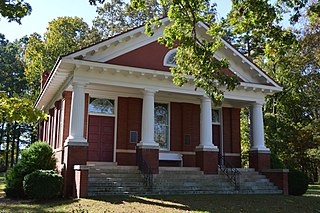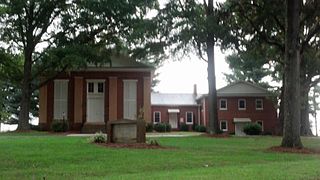
Scotland County is a county located in the southern part of the U.S. state of North Carolina. As of the 2020 census, the population was 34,174. Its county seat is Laurinburg.

Laurinburg is a city in and the county seat of Scotland County, North Carolina, United States. Located in southern North Carolina near the South Carolina border, Laurinburg is southwest of Fayetteville and is home to St. Andrews University. The Laurinburg Institute, a historically African-American school, is also located in Laurinburg. The population at the 2010 Census was 15,962 people.

Thomas Ustick Walter was an American architect of German descent, the dean of American architecture between the 1820 death of Benjamin Latrobe and the emergence of H.H. Richardson in the 1870s. He was the fourth Architect of the Capitol and responsible for adding the north (Senate) and south (House) wings and the central dome that is predominantly the current appearance of the U.S. Capitol building. Walter was one of the founders and second president of the American Institute of Architects. In 1839, he was elected as a member to the American Philosophical Society.

Lamington is an unincorporated community and census-designated place (CDP) located within Bedminster Township in Somerset County, New Jersey, United States. It contains the Lamington Presbyterian Church Cemetery and the Lamington Black Cemetery.

Samuel Sloan was a Philadelphia-based architect and best-selling author of architecture books in the mid-19th century. He specialized in Italianate villas and country houses, churches, and institutional buildings. His most famous building—the octagonal mansion "Longwood" in Natchez, Mississippi—is unfinished; construction was abandoned during the American Civil War.

Laurel Hill is a census-designated place and unincorporated community in Scotland County, North Carolina, United States. It is located northwest of Laurinburg, and southeast of Old Hundred, a neighboring community.

James Graham Ramsay was a North Carolina physician and politician who served in the North Carolina Senate and Confederate States Congress during the American Civil War.

Guinston United Presbyterian Church is a historic Presbyterian church building located at Chanceford Township, Pennsylvania, York County, Pennsylvania. It was built in 1773, and is a one-story, fieldstone building with minimal ornamentation. It features paneled semi-circular inserts above the doors and rounded arch windows. It replaced an earlier log church built in 1754. In 1867, the church began being used as a Sabbath School while a new sanctuary was built nearby.
Hawfields Presbyterian Church is a historic Presbyterian church complex located near Mebane, Alamance County, North Carolina. The congregation was established by settlers in the 1700s. The complex consists of the original church building, the classroom to the rear of it, the Session House, and the cemetery. The current Greek Revival style brick church building was constructed between 1852 and 1855.

Brown Marsh Presbyterian Church, also known as Clarkton Presbyterian Church, is a historic Presbyterian church in Clarkton, Bladen County, North Carolina. The church was organized prior to 1755 by early Scottish settlers. The current building was built in 1818, and is a small frame pre-Greek Revival style building. It is the oldest church in Bladen County.

Griers Presbyterian Church and Cemetery is a historic Presbyterian church and cemetery located near Frogsboro, Caswell County, North Carolina. It was built about 1856, and is a simple, rectangular frame building. It is an example of Greek Revival temple-form church architecture. Also on the property is a contributing church cemetery.

Red House Presbyterian Church, also known as Hugh McAden Gravesite or Red House Church, is a historic Presbyterian church and cemetery located at 13409 NC 119 N in Semora, Caswell County, North Carolina. The Classical Revival red brick church building was constructed in 1913. It features a portico with four round, fluted wooden Doric order columns. Also on the property is a contributing church cemetery.

Old Bluff Presbyterian Church is a historic Presbyterian church located near Wade, Cumberland County, North Carolina.

Ashpole Presbyterian Church is a historic Presbyterian church located near Rowland, Robeson County, North Carolina. It was built in 1860 and is a two-level, three bay by five bay, Greek Revival style frame church. It features an octagonal belfry with a concave cap roof that rests on a tall, square base. At the rear of the church is a modern educational building. Also on the property are the contributing 1+1⁄2-story manse, a square hip-roofed well house, and two-story barn.

Back Creek Presbyterian Church and Cemetery is a historic Presbyterian church and cemetery in Mount Ulla Township, Rowan County, North Carolina currently affiliated with the Presbyterian Church in America (PCA). It was named for a nearby stream, which was back of Sills Creek and called Back Creek.
Third Creek Presbyterian Church and Cemetery is a historic Presbyterian church and cemetery located near Cleveland, Rowan County, North Carolina. The cemetery was added to the National Register of Historic Places in 1983.

First Presbyterian Church, also known as the Church of Christ, Scientist, is a historic Presbyterian church located at 111 W. Ash Street in Goldsboro, Wayne County, North Carolina. It was built in 1856, and is a one-story, stuccoed, temple form Greek Revival architecture style church. It features an in antis portico with Tuscan order columns and low pitched roof with a painted wooden cupola. In 1953, the building was sold to the Christian Science Society.

Long Cane Associate Reformed Presbyterian Church is a historic Associate Reformed Presbyterian church in McCormick County, South Carolina four miles west of Troy, South Carolina on SC 33-36. Adjacent to the church building is a cemetery dating to circa 1790.

The Central School, also known as Laurinburg Graded School, is a historic school building located at Laurinburg, Scotland County, North Carolina. The original section was designed by architect Oliver Duke Wheeler and built in 1909–1910. It is a two-story, brick building in Neoclassical style. The main entrance features a prominent central portico with four Doric order columns. Two-story flanking wings were added in 1939, and additions to the wings were made in 1948 and 1949 and designed by Leslie Boney. The school closed in 2000.

Laurinburg Commercial Historic District is a national historic district located in Laurinburg, North Carolina. The district encompasses 51 contributing buildings and 2 contributing structures in the central business district of Laurinburg.





















